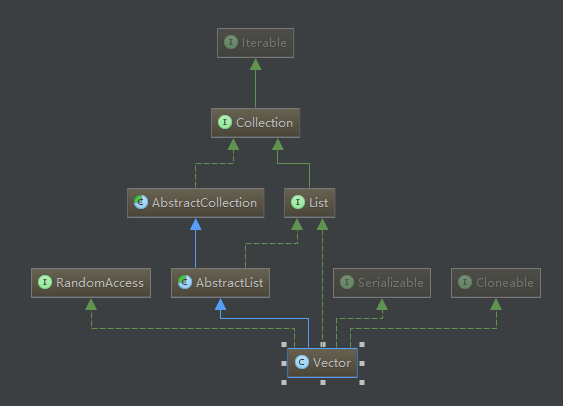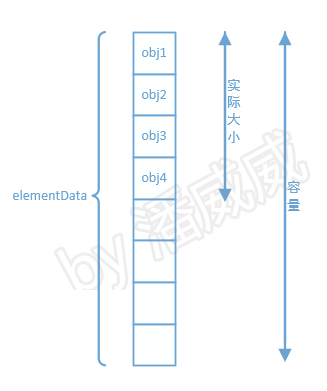容器源码分析之——Vector
一、Vector简介
1.1 类继承结构

1.2 数据结构

二、源码
2.1 注释
Vector与ArrayList是非常相似的,注释中的说明也是类似的,可参考上篇博文“ArrayList源码阅读”。注释中有这样一句话:“Vector是同步的,如果不需要线程安全的实现,推荐使用ArrayList代替Vector”。
2.2 定义
public class Vector<E> extends AbstractList<E>
implements List<E>, RandomAccess, Cloneable, java.io.Serializable
类定义与类继承结构图是对应的。
从中我们可以了解到:
- Vector
:说明它支持泛型。 - extends AbstractList
:继承了AbstractList。AbstractList提供List接口的骨干实现,以最大限度地减少“随机访问”数据存储(如ArrayList)实现Llist所需的工作。 - implements List
:实现了List。实现了所有可选列表操作。 - implements RandomAccess:表明Vector支持快速(通常是固定时间)随机访问。此接口的主要目的是允许一般的算法更改其行为,从而在将其应用到随机或连续访问列表时能提供良好的性能。
- implements Cloneable:表明其可以调用clone()方法来返回实例的field-for-field拷贝。
- implements java.io.Serializable:表明该类具有序列化功能。
2.3 域
/**
* 保存vector元素的数组,数组的长度就是vector的容量,vector的容量至少要能
* 保存所有的元素
*
* <p>任何在vector最后一个元素之后的数组元素都是null
*
* @serial
*/
protected Object[] elementData;
/**
* vector中的实际元素数
* {@code elementData[elementCount-1]} are the actual items.
*
* @serial
*/
protected int elementCount;
/**
* vector在自动扩容时增加的容量,当vector的实际容量将要大于它的最大容量时,vector自动增加的容量
* 当该值<=0时,vector的容量需要扩容时就扩为原来的2倍
*
* @serial
*/
protected int capacityIncrement;
/** use serialVersionUID from JDK 1.0.2 for interoperability */
private static final long serialVersionUID = -2767605614048989439L;
查看上面源码中的注释即可,比较简单。
2.4 构造方法
/**
* 构造一个指定初始容量为initialCapacity,自增容量为capacityIncrement的空vector
* @throws IllegalArgumentException if the specified initial capacity
* is negative
*/
public Vector(int initialCapacity, int capacityIncrement) {
super();
if (initialCapacity < 0)
throw new IllegalArgumentException("Illegal Capacity: "+
initialCapacity);
this.elementData = new Object[initialCapacity];
this.capacityIncrement = capacityIncrement;
}
/**
* 构造一个指定初始容量为initialCapacity,自增容量为0的空vector
* 实际上里面调用的是上一个构造函数
* @throws IllegalArgumentException if the specified initial capacity
* is negative
*/
public Vector(int initialCapacity) {
this(initialCapacity, 0);
}
/**
* 构造一个指定初始容量为10,自增容量为0的空vector
* 实际上调用的是上一个构造函数
*/
public Vector() {
this(10);
}
/**
* 使用指定的Collection构造vector
* @throws NullPointerException if the specified collection is null
* @since 1.2
*/
public Vector(Collection<? extends E> c) {
elementData = c.toArray();
elementCount = elementData.length;
// c.toArray might (incorrectly) not return Object[] (see 6260652)
if (elementData.getClass() != Object[].class)
elementData = Arrays.copyOf(elementData, elementCount, Object[].class);
}
共有四个构造函数
- public Vector(int initialCapacity, int capacityIncrement)
- public Vector(int initialCapacity)
- public Vector()
- public Vector(Collection<? extends E> c)
2.5 核心方法
Vector类所有被外部访问到的方法,都是线程同步的,实现方法是“synchronized”的关键字。举几个栗子
2.5.1 copyInto(object[] anArray)
/**
* 将vector的所有元素复制进指定的数组anArray中
* The item at index {@code k} in this vector is copied into
* component {@code k} of {@code anArray}.
*
* @param anArray the array into which the components get copied
* @throws NullPointerException if the given array is null
* @throws IndexOutOfBoundsException if the specified array is not
* large enough to hold all the components of this vector
* @throws ArrayStoreException if a component of this vector is not of
* a runtime type that can be stored in the specified array
* @see #toArray(Object[])
*/
public synchronized void copyInto(Object[] anArray) {
System.arraycopy(elementData, 0, anArray, 0, elementCount);
}
方法被synchronized关键字修饰。
2.5.2 trimToSize()
/**
* 将底层数组的容量调整为当前vector实际元素的个数,来释放空间
*/
public synchronized void trimToSize() {
modCount++;
int oldCapacity = elementData.length;
//当实际元素个数小于底层数组的长度
if (elementCount < oldCapacity) {
//将底层数组的长度调整为实际大小
elementData = Arrays.copyOf(elementData, elementCount);
}
}
** 小结:Vector与ArrayList的最大不同就是它的方法是线程同步的,实现同步的方式就是用“synchronized”修饰方法。**
2.6 扩容机制
/**
* 为保证vector可以容纳所有需要容纳的元素,在必要时进行扩容
* 扩容规则:
* 1、capacityIncrement大于0时,新的容量将在旧的容量的基础上加上capacityIncrement;
* 小于0时,增加到原来的2倍。
* 2、如果新的容量还是小于至少需要的容量,则将容量扩容为至少需要的容量。
* 3、如果至少需要的容量大于MAX_ARRAY_SIZE,则进行大容量分配,hugeCapacity()函数中进行
* @param minCapacity the desired minimum capacity
*/
public synchronized void ensureCapacity(int minCapacity) {
if (minCapacity > 0) {
modCount++;
ensureCapacityHelper(minCapacity);
}
}
/**
* ensureCapacity()方法的unsynchronized实现。
*
* ensureCapacity()是同步的,它可以调用本方法来扩容,而不用承受同步带来的消耗
*
* @see #ensureCapacity(int)
*/
private void ensureCapacityHelper(int minCapacity) {
// 如果至少需要的容量 > 数组缓冲区当前的长度,就进行扩容
if (minCapacity - elementData.length > 0)
grow(minCapacity);
}
/**
* 分派给arrays的最大容量
* 为什么要减去8呢?
* 因为某些VM会在数组中保留一些头字,尝试分配这个最大存储容量,可能会导致array容量大于VM的limit,最终导致OutOfMemoryError。
*/
private static final int MAX_ARRAY_SIZE = Integer.MAX_VALUE - 8;
** 小结:ArrayList和Vector的扩容逻辑稍微有些不同。vector的逻辑是: newCapacity = oldCapacity + ((capacityIncrement > 0) ? capacityIncrement : oldCapacity); 即如果capacityIncrement>0,就加capacityIncrement,如果不是就增加一倍。
而ArrayList的逻辑是:
newCapacity = oldCapacity + (oldCapacity >> 1); 即增加现有的一半。
后面的大容量分配逻辑是一样的。**


 浙公网安备 33010602011771号
浙公网安备 33010602011771号